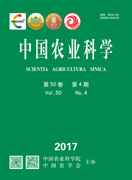【Objective】In order to conduct maker assisted selection, the aim of this study is to find molecular markers related to mastitis resistance by identifying and screening relevant genes through genome-wide association study.【Method】A total of 2093
Chinese Holsteins SCC in Beijing region were log-transformed to LASCS and SCS-SD which were following normal distribution
according to formula LASCS=log2 and SCS-SD=log2 . LASCS and SCS-SD were divided into two groups
including mastitis susceptive cows (Case) and resistant cows (Control) based on half of standard deviation (0.5 SD) and one standard deviation (1 SD) of LASCS and SCS-SD. The unqualified SNPs were deleted after quality control for 54 001 SNPs by the criteria: call rate < 90 %, SNPs deviated extremely from Hardy-Weinberg equilibrium (P < 10E−6) and minor allele frequency < 0.03. Case-control association testing for LASCS and SCS-SD were further performed by ROASTRIPS software (version 1.2) which contains 3 tests: RM test, RCHI test and RW test. Bonferroni multiple testing was adopted to adjust the results of association analysis on each chromosome level. The number of SNPs on each chromosome divided by 0.05 was considered as the significant chromosome level. At the same time, LASCS and SCS-SD of all the individuals were considered as the continual traits for association analysis by using linear mixed model method. The results were further confirmed after comparing to case-control method.【Result】For the divided population by 0.5 SD and 1 SD, a total of 1371 and 708 individuals were used for LASCS association analysis as well as 1385 and 716 individuals used for SCS-SD association analysis, respectively. After quality control by deleting unqualified SNPs, a total of 43781/43671 (43817/43704) SNPs were available for 0.5 SD/1 SD of LASCS (SCS-SD), respectively. Through Bonferroni correction at chromosome level (P < 0.05) after association analysis, 5 SNPs were detected significantly including 3 SNPs located at chromosome X and 2 other SNPs located on chromosomes 7 and 28, separately. One genome-level significant SNP (Hapmap48573-BTA-104531) was identified on chromosome X for 0.5 SD of SCS-SD by RCHI test (P = 1.14E-06). The results showed that the significant SNPs (Hapmap48573-BTA-104531 and Hapmap54175-rs29021817) on chromosome X were located in gene IL1RAPL2 and the significant SNP on chromosome 7 was close to ILF3 gene which is related to inflammation response. These two genes (IL1RAPL2 and ILF3) are relevant to interleukins while interleukins 4, 5, 6, 12, 13, 17, 22, and 23 play an important role when participating in different inflammation responses. The function of ILF3 gene is a translation inhibitory protein as a member of interleukins. The current study also used linear mixed model to perform association analysis on LASCS and SCS-SD, and identified the same SNP (BTA-28466-no-rs) on chromosome X detected by case-control method. Compared to two methods (Linear mixed model method and case-control method), the same SNPs could be found by two methods for the same traits while association results were various for different traits.【Conclusion】The results of the study have found the genes related to inflammation response of mammary gland which provide fundamental data for molecular genetic basis of mastitis resistance in dairy cattle.









